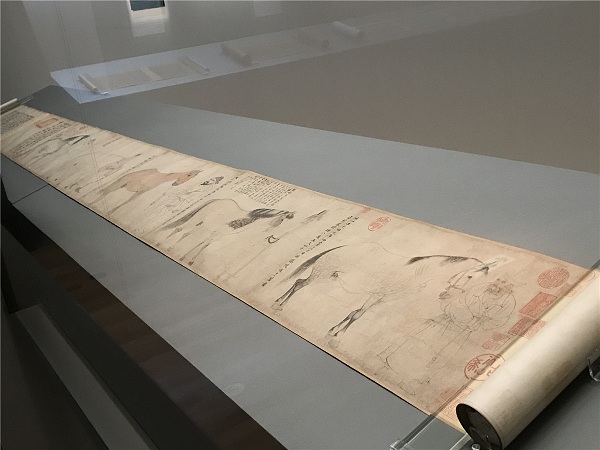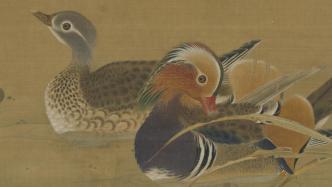
The National Palace Museum in Taipei's "Songs of Pen, Ink and Dance - A Guide to the Paintings of the National Palace Museum (2024-I)" will have a new exhibition before New Year's Day in 2024. The figure portraits from the cliff tombs in Xinjin, Sichuan during the Eastern Han Dynasty, Song Mi Youren's "The Intention of Yunshan", Qian Xuan's " "Peony", Yuan Guo's "Snow Bamboo Picture", Ming and Tang Yin's "Jin Chang Farewell Intentions", Ming Anonymous "(Biography) Huizong's Sketch of Feathers", modern Zhang Daqian's "Copying of the Deer King Bunsen Picture of Mogao Grottoes" and other outstanding calligraphy and painting works of all dynasties. display.
The development of ancient paintings is like a wonderful symphony, using typical styles of figures, flowers, birds, landscapes and other painting disciplines to form several important themes and add variations in the historical context.
The model of figure painting was gradually established by Gu Kaizhi, Wu Daozi and others from the Six Dynasties to the Tang Dynasty (220-907). The classic landscape painting took shape around the Five Dynasties (907-960), and it embodies the characteristics of geographical regions. For example, Jing Hao and Guan Tong painted northern landscapes, while Dong Yuan and Ju Ran painted the landscapes of Jiangnan water towns. In terms of flower and feather paintings, Huang Quan from Sichuan and Xu Xi from Jiangnan also formed two different models.

Song Mi Youren Yunshan's intention
In the landscape paintings of the Song Dynasty (960-1279), Fan Kuan, Guo Xi, and Li Tang all introduced new models based on existing models and became new models. Under the initiative of the art emperors of the Song Dynasty, the Palace Painting Academy developed to an unprecedented level. Painters at that time paid attention to the observation of nature and added "poetry" to enhance the connotation and artistic conception of the painting. The interest in physical objects led to painting types that focused on mechanical structures such as buildings and ships and carriages, which jumped onto the stage of painting after the eleventh century. The emphasis on poetry led to the development of fine albums in the Southern Song Dynasty that combined calligraphy, poetry, and painting. In addition, literati in the Song Dynasty also expanded the concept of artistic expression beyond "shape resemblance", and literati painting began to become a new style.
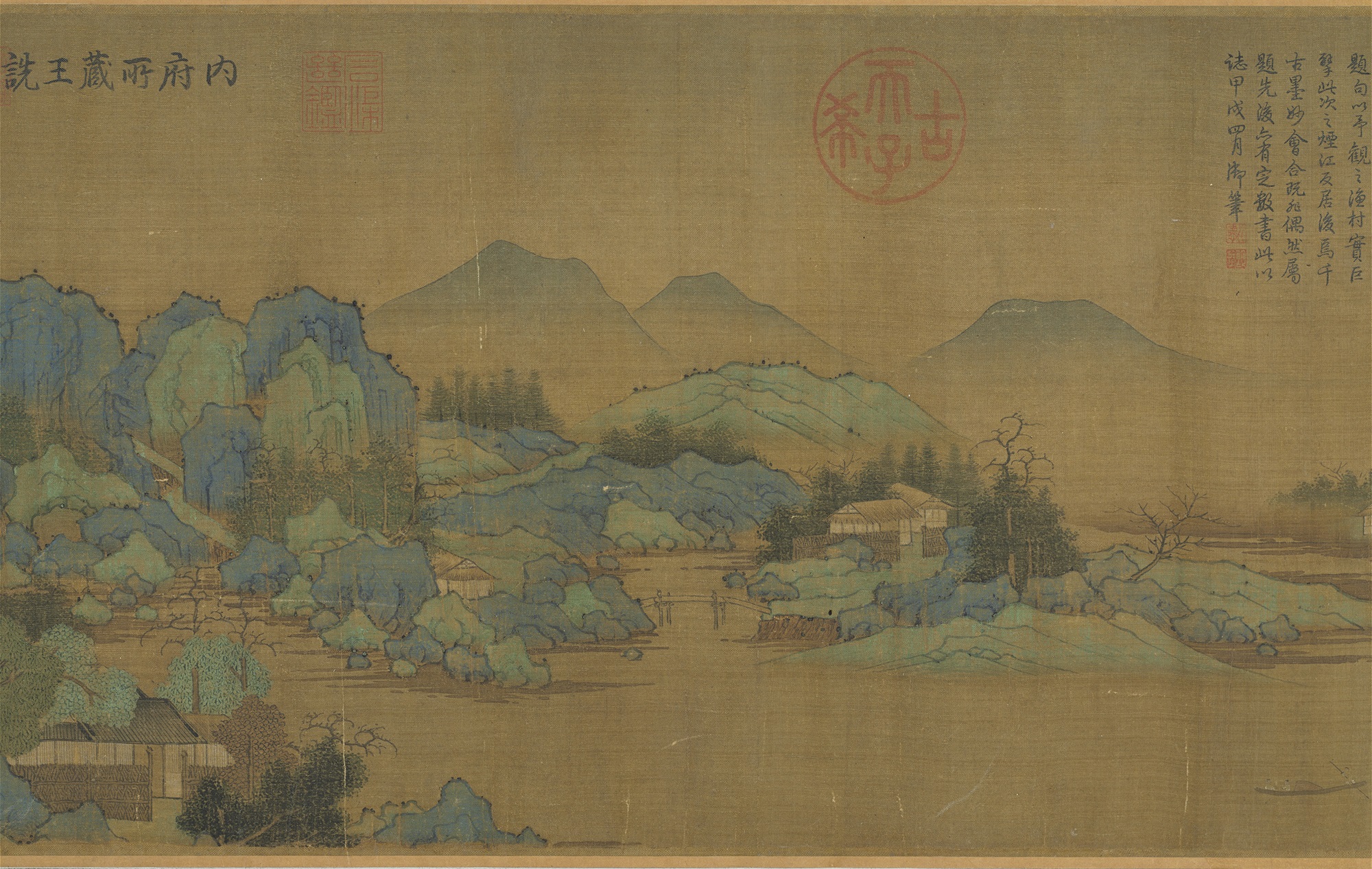
Song Qianxuan (Biography) Wang Xueying Mountain Pictures
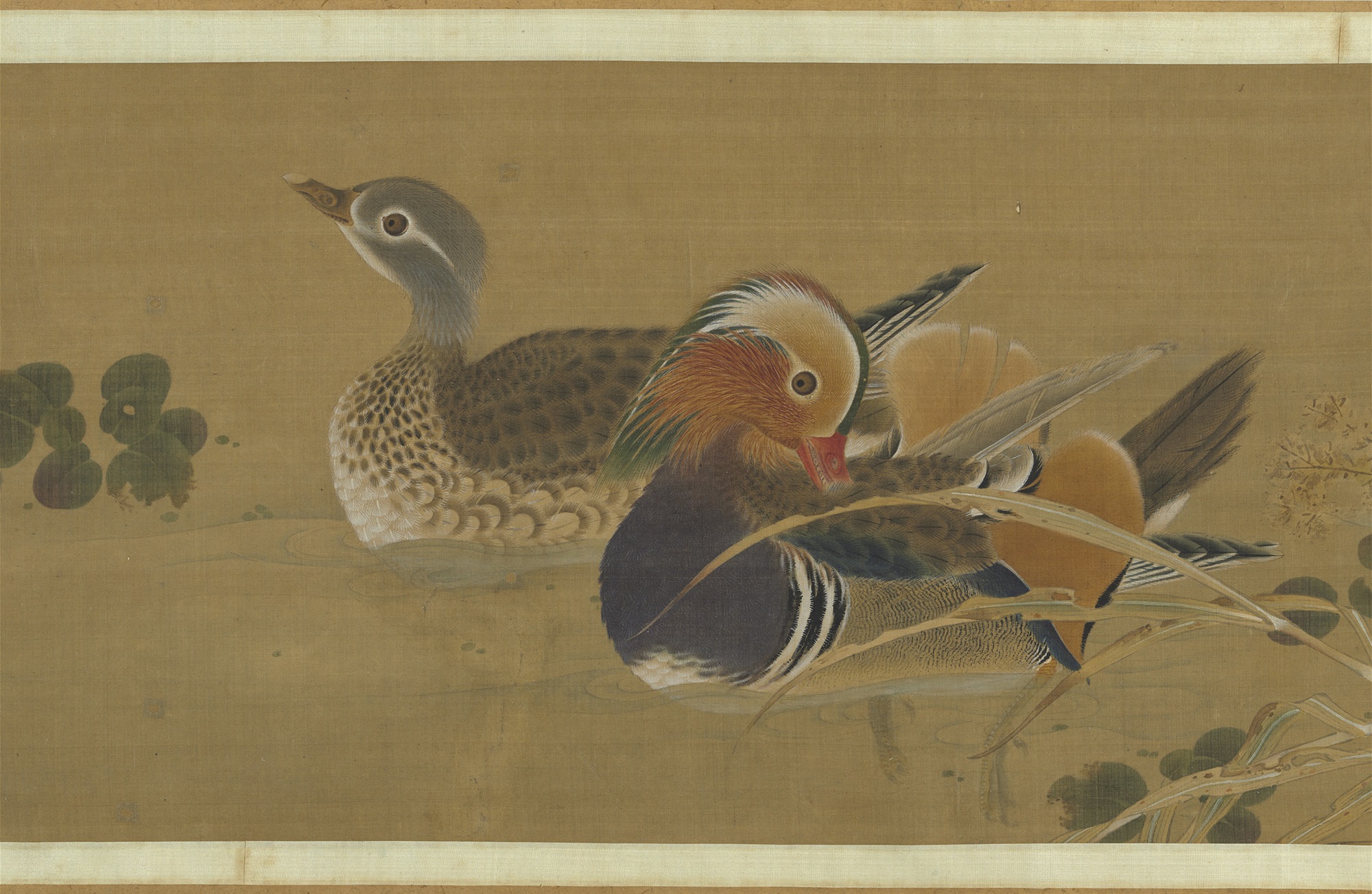
Ming Dynasty Anonymous (Biography) Huizong's Sketch of Feathers
The literati paintings of the Yuan Dynasty (1279-1368) were directed by Zhao Mengfu, the Four Great Masters of the Yuan Dynasty (Huang Gongwang, Wuzhen, Ni Zan, Wang Meng) and others, and had more diverse styles due to the retro. These styles gradually became important models in the development of painting and maintained continued influence after the Ming and Qing Dynasties.
After the Ming Dynasty (1368-1644), the styles and characteristics of different regions have become an important link in the development of art. The "Wu School" in Suzhou evolved an elegant literati style from the four great masters of the Yuan Dynasty, while the "Zhe School", which is mainly composed of Zhejiang and Fujian painters, developed from court painting and turned the Southern Song Dynasty's model into extensive ink painting. Dong Qichang of Songjiang and later Wang Shimin, Wang Jian, Wang Hui and Wang Yuanqi continued to use pen and ink to recreate nature in the "gathering" of ancient models, forming the "orthodox school" with far-reaching influence.
The emperors of the Qing Dynasty (1644-1911), while advocating the "orthodox" style, also tolerated the Western painting methods brought by European missionaries. Three-dimensional and perspective became new interpretations of ancient models. Outside the palace, in Yangzhou, a group of painters who advertised themselves as "weird and bizarre" were active in a highly commercialized market. Their words and images were aimed at "unorthodox" models, and they themselves became the paradigmatic basis for future generations to pursue change.
narrative painting
Anonymous figure portrait stone from a cliff tomb in Xinjin, Sichuan during the Eastern Han Dynasty

Anonymous figure portrait stone from a cliff tomb in Xinjin, Sichuan during the Eastern Han Dynasty
This piece is a reprint of the side portrait stone of a cliff coffin from the Eastern Han Dynasty unearthed in Xinjin County, Sichuan Province. There are three pictures on the left and right, showing three stories. "Confucius Meets Laozi" on display this time is the only one in Sichuan. It is generally believed that this story reflects the Han Dynasty's ideas of respecting teachers, asking questions, studying saints, and seeking immortality. However, this painting only depicts Laozi (6th-5th century BC), Confucius (551-479 BC) and their students. The content is different from other Each region is different and may have a more unique and unknown meaning.
Picture of the Solitary Paradise of Sima Guang, Anonymous in the Song Dynasty

Picture of the Solitary Paradise of Sima Guang, Anonymous in the Song Dynasty
In 1073, Sima Guang built Du Paradise in Luoyang. He and his family lived in the garden for 15 years, where they compiled "Zi Zhi Tong Jian" and held elegant gatherings. Duyuan Garden profoundly reflects his state of life and outlook on life, and has also become a representative work of literati gardens in the Northern Song Dynasty. This painting was painted by a Song Dynasty person. There is no one in the painting. However, in terms of the structure of the park and the simple garden style, it is highly consistent with various historical records. Therefore, it is more like a three-dimensional architectural diagram than other independent garden paintings. It will also contribute to the recovery of the park.
Anonymous (Biography) Song Dynasty Guo Zhongshu came to Wang Wei Wangchuan Picture

Anonymous (Biography) Song Dynasty Guo Zhongshu came to Wang Wei Wangchuan Picture
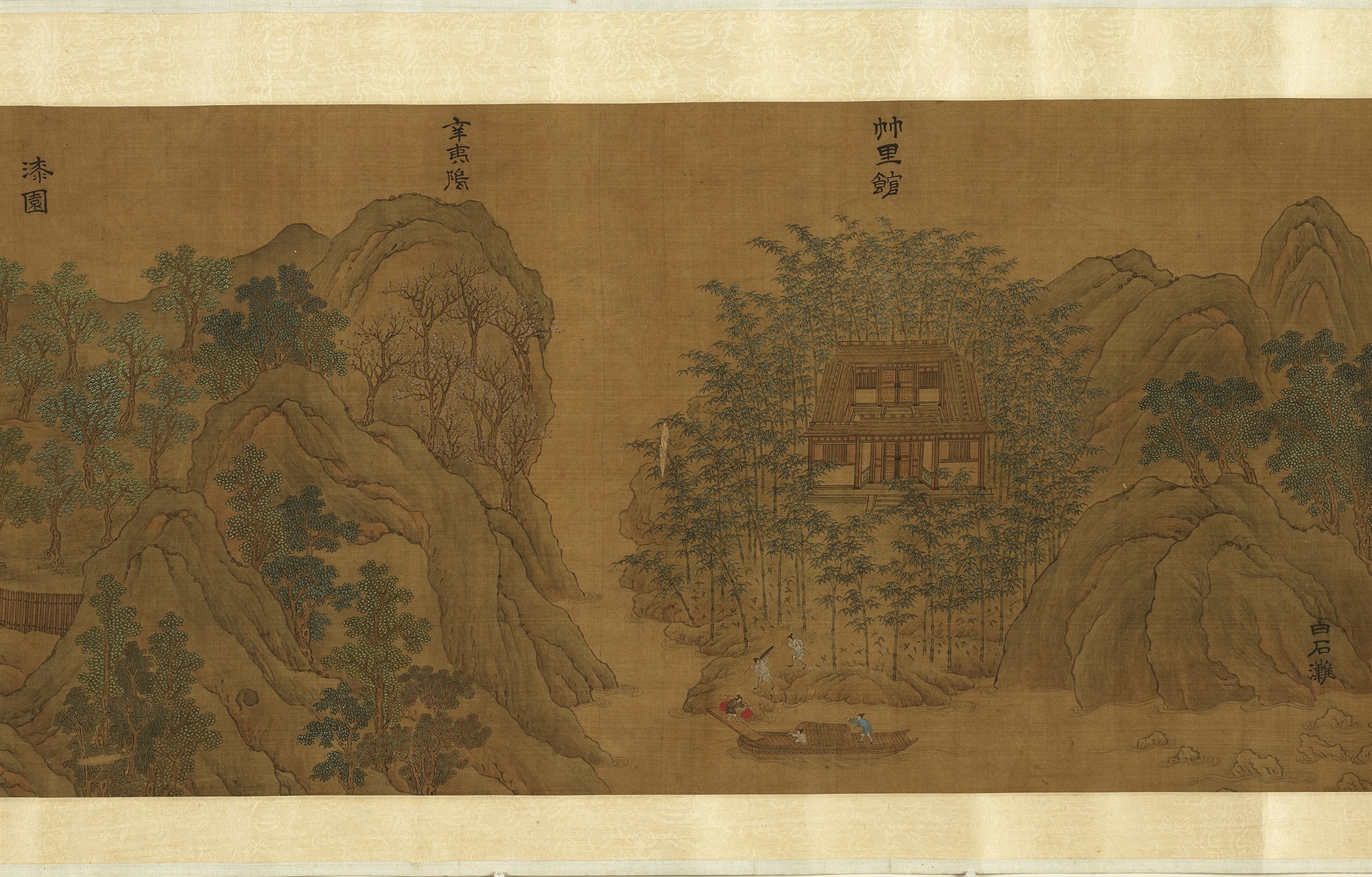
Anonymous (Biography) Song Dynasty Guo Zhongshu came to Wang Wei Wangchuan Picture

Anonymous (Biography) Song Dynasty Guo Zhongshu came to Wang Wei Wangchuan Picture

Anonymous (Biography) Song Dynasty Guo Zhongshu came to Wang Wei Wangchuan Picture
Since the Tang Dynasty, "Wangchuan Picture" has been regarded as a painting by Wang Wei (701-761) himself depicting twenty scenes from his "Wangchuan Collection". Among the later copies, it is said that the work by Guo Zhongshu (?-977) has the most ancient meaning. However, some studies have pointed out that later generations' copies were created without understanding the topography of Wang Valley and the content of Wang Wei's poems. For example, the Wuguan Post Road is not shown in "Jinzhuling" and "Gonghuaimo" in this painting, and the titles of "Nan Cong" and "Bei Cong" are reversed, which shows the fallacy of copying and the speculation of King Wang since the late Ming Dynasty. The trend of dimension industry.
Ming Dynasty Zheng Zheng's imitation of Wang Meng Ge Hong's emigration map

Ming Dynasty Zheng Zheng's imitation of Wang Meng Ge Hong's emigration map
This painting depicts the story of Taoist priest Ge Hong (283-343) who moved to Luofu Mountain to refine alchemy and practice Taoism. In the painting, there are cascading mountains, twists and turns of mountain paths, flowing water, verandas, shrouded clouds and mist, and flying cranes in the sky, giving it a mysterious atmosphere of a fairyland. The brush is imitated by Wang Meng (1308-1385), with fine and dense lines, bright and elegant colors, and both the interest of pen and ink and the decorative effect. It is in line with the comments of later generations that "imitation of famous artists of Song and Yuan Dynasty, refined body and rhyme".
Ming Dynasty Shengmo's picture of flying cranes on the solitary mountain
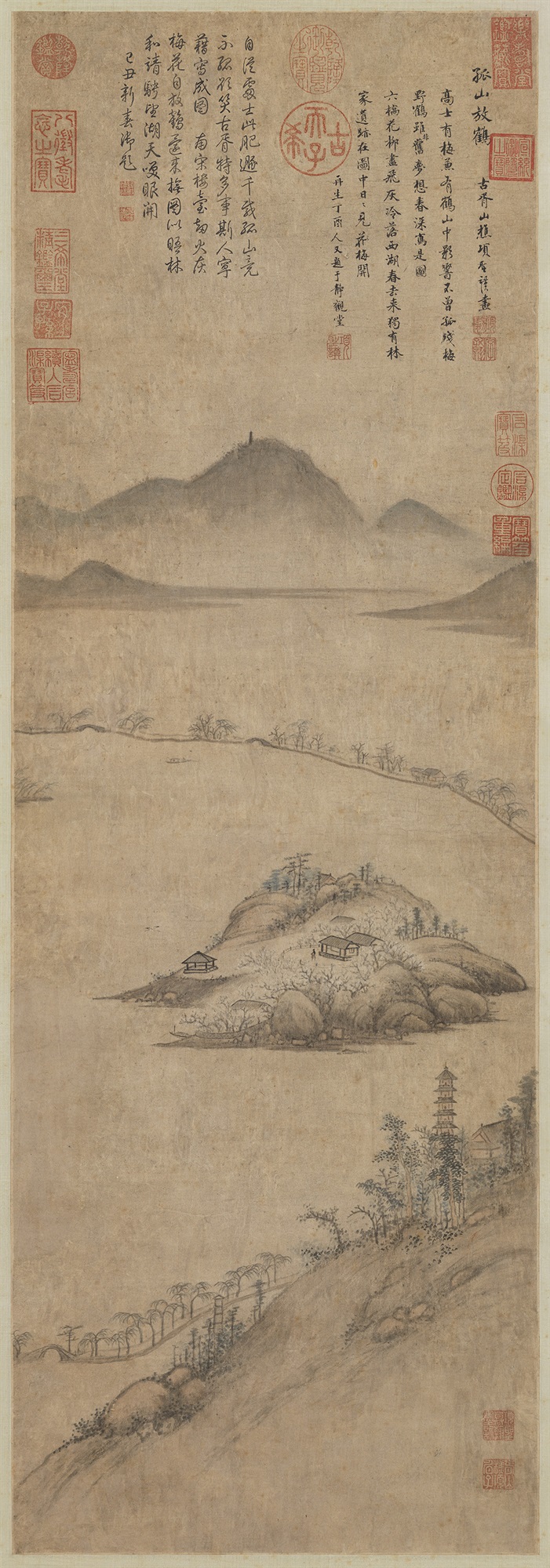
Ming Dynasty Shengmo's picture of flying cranes on the solitary mountain
Xiang Shengmo (1597-1658), courtesy name Kongzhang, nicknamed Yi'an, Guxu Shanqiao, etc., was a painter among the survivors in the late Ming and early Qing dynasties and a representative of the "Jiaxing Painting School". This painting depicts the story of Lin Hejing living in seclusion on a lonely mountain in the West Lake, and incorporates the content of Su Shi's "The Crane-Felting Pavilion". A person looks up in the plum grove on a hill, and a crane returns to the railing outside the pavilion. It is surrounded by Su and Bai embankments and Baochu Pagoda in a concentric circle, which further highlights the intimacy and independence of people, cranes, plum trees and hills. Real scenes, anecdotes and articles are intertwined in the picture, which is deeply creative, clear and meaningful.
The story of Puru Taiping Guangji in the Republic of China

The story of Puru Taiping Guangji in the Republic of China

The story of Puru Taiping Guangji in the Republic of China
"Taiping Guangji" was compiled in 978, with a total of more than 500 stories. There are 26 pages in this volume by Pu Ru. Each scene represents a story, condensing the climax scene into a very small size, with exquisite brushwork and elegant style. The original text is also recorded above, with elegant and elegant calligraphy. The whole volume is supplemented by pictures and texts, which are either bizarre, humorous, sarcastic, or warning, as if they are chatting and laughing with the viewer in the study, and have a deep literary atmosphere. This selection of exhibitions includes "Burning Dragon", "Yao Xiaopin", "Stone Turtle on the Shore" and "Seng Zhitong".
Zhang Daqian's copy of the Jataka painting of the Deer King in Mogao Grottoes during the Republic of China

Zhang Daqian's copy of the Jataka painting of the Deer King in Mogao Grottoes during the Republic of China

Zhang Daqian's copy of the Jataka painting of the Deer King in Mogao Grottoes during the Republic of China

Zhang Daqian's copy of the Jataka painting of the Deer King in Mogao Grottoes during the Republic of China
Zhang Daqian (1899-1983), a modern calligrapher and painter, famously known as Yuan, also known as Dafengtang, is world-renowned for his splash-ink and splash-color painting style.
Jataka stories refer to Sakyamuni's reincarnation and education of sentient beings before he became a Buddha. This volume is copied from Cave No. 257 of the Dunhuang Academy, and depicts the story of the Deer King saving the deer herd and influencing the king. The original work is the only Deer King mural in Dunhuang. It breaks through the limitations of the plot and arranges the climax of the Deer King facing the king in the center of the picture, which reflects the ingenuity of the composition of the mural and the space of the grotto. However, it has been in existence for more than 1,500 years, and its color has changed greatly. Fortunately, this copy can restore its original appearance. This painting was donated by Mr. Zhang Daqian.
animal painting
Picture of Tigers in Ruyin Fenglin, Zhao Dynasty, Ming Dynasty
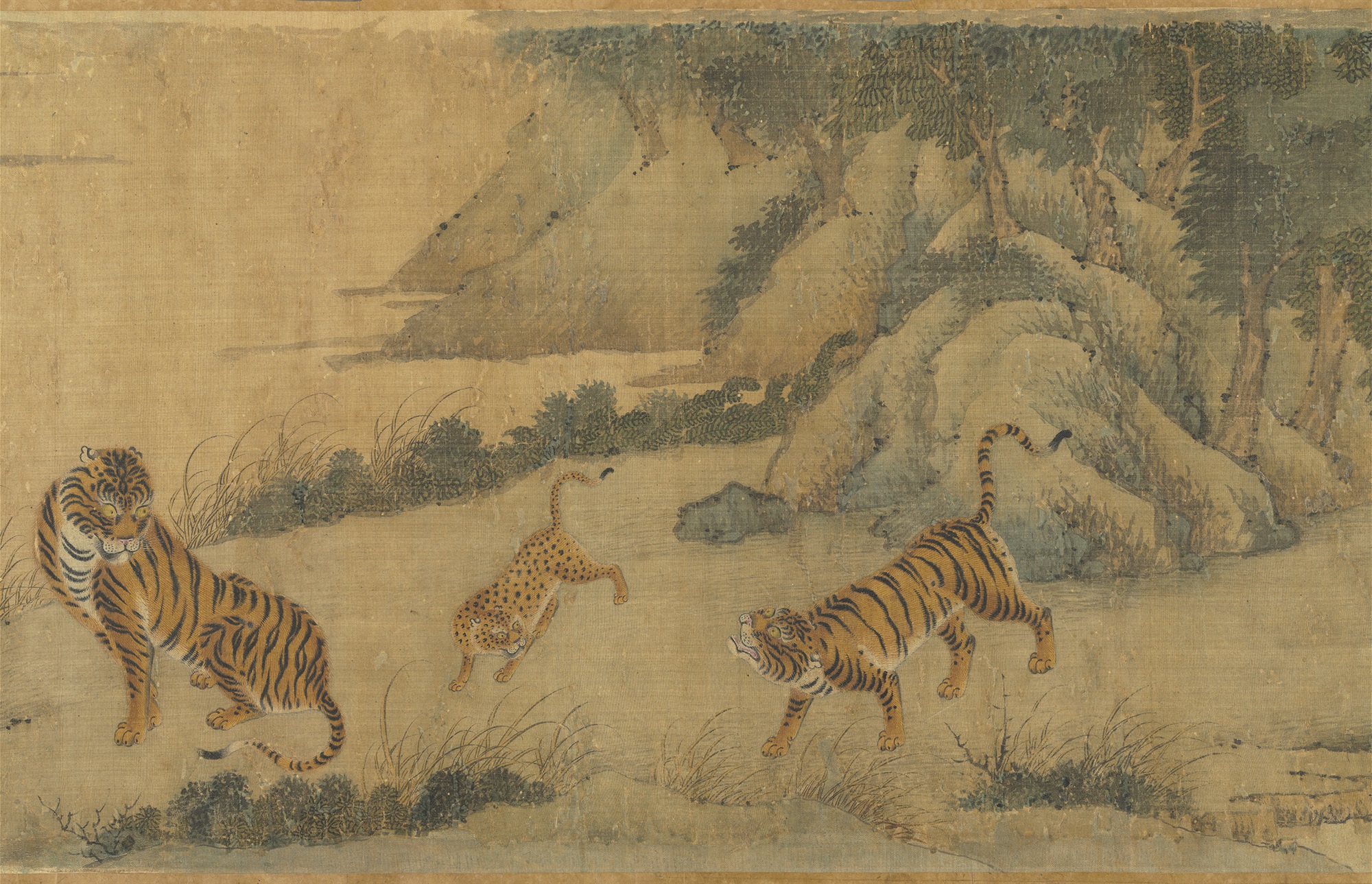
Picture of Tigers in Ruyin Fenglin, Zhao Dynasty, Ming Dynasty
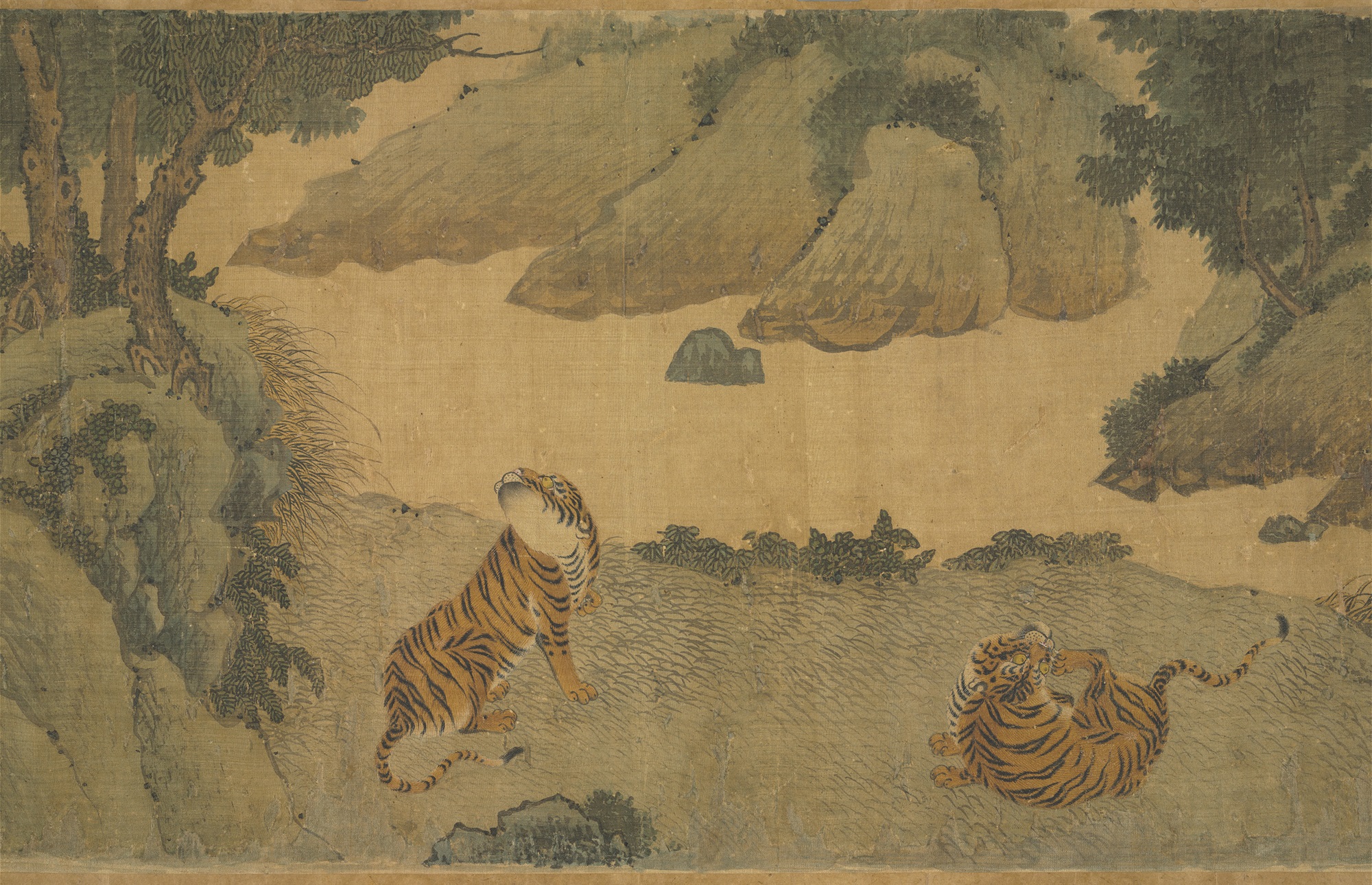
Picture of Tigers in Ruyin Fenglin, Zhao Dynasty, Ming Dynasty
In the middle of the river, islands stand tall, surrounded by wind and waves on the shore, with the potential to fly. There is a dock nearby, and two river boats are docked here together. The islands in the center of the river are very special, with trees, temples, and pagodas all in great detail. Although it was originally titled as a painting by Li Tang, its style is different from Li Tang's vigorous and hard-drawn painting, and the brushwork is close to the treatment method in Guo Xi's "Early Spring Picture". The outline of the main peak of the island has great fluctuations, which is close to Guo Xi's close-up boulders. The clean and smooth feeling of the whole painting is also close to the changing peaks and clouds in "Early Spring Picture". Therefore, it is speculated that it may be from the Xuanhe or Shaoxing period (1119) -1162) A masterpiece of the Guoxi school of painters.
Ming Dynasty Anonymous (Biography) Huizong's Sketch of Feathers

Ming Dynasty Anonymous (Biography) Huizong's Sketch of Feathers
There are two paintings in this volume, both of which are meticulous and colorful. The first painting, seven birds and one butterfly among lychees and gardenias, is from the same manuscript as the one in the British Museum. However, the image shapes, details and spatial sense of the picture in this volume in the collection are more rigorous and accurate, and the painting techniques are richer. For example, the boneless method is used to draw gardenia branches, and the outline method is used to draw the leaves, and then combined with color rendering, stitching or overlapping effects to express the thin and stiff texture of the branches and the dry leaves. According to Xiang Yuanbian (1525-1590), the seals are so lifelike that they should be copied by Gao Ming in the 17th century. The second painting contains lotuses and mandarin ducks, and is even more exquisitely crafted than the previous one. The shape is accurate and the colors are bright and elegant. The brushwork is meticulous and varied, and the textures of various feathers and leaves are drawn one by one. The bird's claws in the water are vivid. It is believed to be a masterpiece of the 17th century.
landscape painting
Song Mi Youren Yunshan's intention

Song Mi Youren Yunshan's intention
Mi Youren (1074-1151), the eldest son of Mi Fu (1051-1107), inherited the family education, was good at calligraphy and painting, and had a fine appreciation of calligraphy and painting. This painting uses peaks, mountains, sea of clouds, and houses as its motifs. Only the peaks, treetops, and roofs are drawn, without the ground, to express the landscape from a high altitude. According to Mie's own inscription at the end of the volume, it should have been written before 1135. It is possible that both the scroll and the rice title are copies and are closely related to the "Xiaoxiang Picture" collected in the Shanghai Museum. This may reflect that the Yunshan Picture in the Yuan Dynasty had the meaning of farewell, missing relatives, and seclusion.
Song Qianxuan (Biography) Wang Xueying Mountain Pictures

Song Qianxuan (Biography) Wang Xueying Mountain Pictures
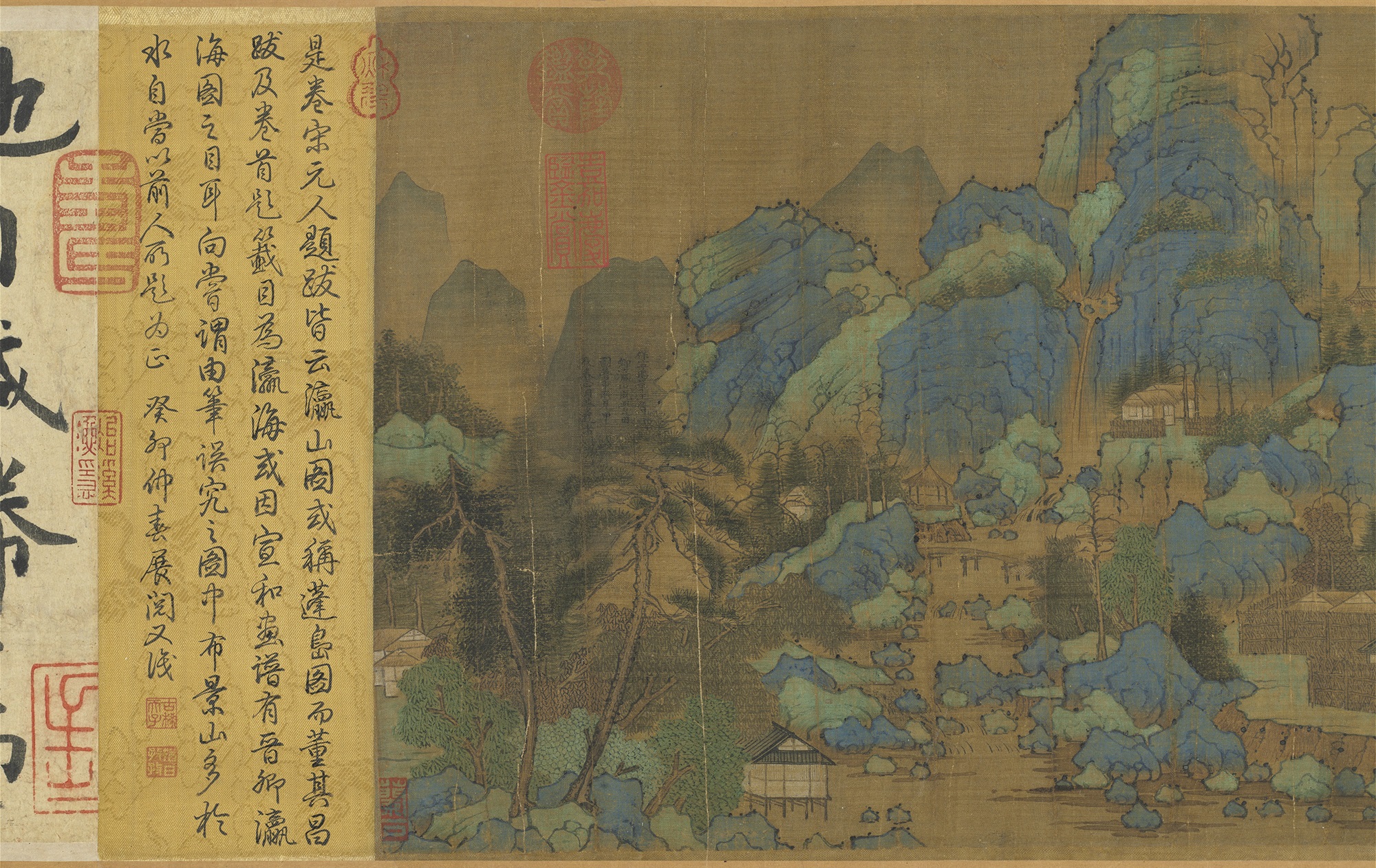
Song Qianxuan (Biography) Wang Xueying Mountain Pictures
The left half of this painting depicts mountains, ravines, and mountain villages; the right half depicts a vast river and a few small boats. The empty river surface contrasts with the majestic mountains, and the composition is both hand-scrolled and panoramic. The objects are simple in shape and the writing is meticulous. The rocks are not cracked and are supplemented by greenery, giving it a quaint and slightly decorative feel. The date of the inscription, 1064, does not match the life of Wang Shen (ca. 1048-1122), and the painting style is also different from that of Wang Shen, who is close to Qian Xuan (1239-ca. 1301). The half-printed postscript with the word "长" in it is also in the collection of Huang Tingjian's (1045-1105) Songfeng Pavilion Poems, which may have been imitated by Qian Xuan for Jia Sidao (1213-1275) in his early years.
Ming Jinxuan (biography) Gao Kegong's picture of waterfalls in the clouds

Ming Jinxuan (biography) Gao Kegong's picture of waterfalls in the clouds
This painting uses horizontal ink dots instead of vertical scrolls to depict landscapes using the chamfering method. Although the scale is small, the mountains are majestic and indeed have the style characteristics of Gao Kegong (1248-1310), except for the inscriptions. The grid-style "rice dots" and Z-shaped composition all over the painting, combined with the favorite motifs of Jiangnan literati paintings such as low trees, study rooms, paths, and short bridges, reveal the atmosphere of the Ming Dynasty. Based on the above characteristics, it is speculated that this painting may be a painting and poem written by Jin Xuan (active 1403-1424), with fake inscriptions added. Jin Xuan, courtesy name Wending, was born in Huating. He was famous for his landscape paintings imitating those of Gao Kegong and Huang Gongwang (1269-1354).
Painting of green fragrant spring by Zou Heng, a scholar of Zhu Zong in Ming Dynasty

Painting of green fragrant spring by Zou Heng, a scholar of Zhu Zong in Ming Dynasty

Painting of green fragrant spring by Zou Heng, a scholar of Zhu Zong in Ming Dynasty
This painting was probably made by Zhu Zongru (active 1488-1505) for Jiaxing native Zou Heng (1467-1506) in 1497. It depicts the ancient well named "Green Fragrance Spring" by Zou Heng outside the city gate, as well as the ancient well next to it. study. Zou Heng's courtesy name is Ruping, his nicknames are Dongqiu and Dan'an, and he is the author of "Jiaxing Zhibu". He wrote an article at the end of the volume to explain the reasons for the drawing, and invited 18 artists including Tu Xun (1446-1516), Qian Fu (1461-1504), and Tang Yin (1470-1524) to write tributes in order to shape the "Green Fragrant Spring" into a The cultural landscape with connotations of morality and elegance also witnessed the literati's singing and calligraphy exchanges.
The farewell intention of Yin and Jin in Ming and Tang Dynasties

The farewell intention of Yin and Jin in Ming and Tang Dynasties
Tang Yin (1470-1524), a native of Suzhou, had the courtesy name Bohu and the nickname Liuru. He was recognized in the Nanjing Provincial Examination in 1498 and became one of the four great masters of the Ming Dynasty.
This painting shows the people of Suzhou farewell to the prefect Zheng Chuzhi (circa 15th century). Deep in the frost forest at the beginning of the volume, city towers, city gates, and distant towers loom, and the wooden bridge outside the city has high arches, and boats and pedestrians are passing up and down. The officials and people on the shore gathered at the dock, saying farewell to each other. The one who looked back and bowed to the soldiers and people was the Zheng family. The whole work is a fusion of the styles of Huang Gongwang (1269-1354) and Zhou Chen (ca. 1450-1535). The brushwork seems to be scrawled, but the lines are vigorous and sharp. Therefore, Wang Mingdeng (1535-1612) praised in his postscript that "the brushwork is unrestrained and the mood is extraordinary." .
botanical painting
Song Qian selects peonies
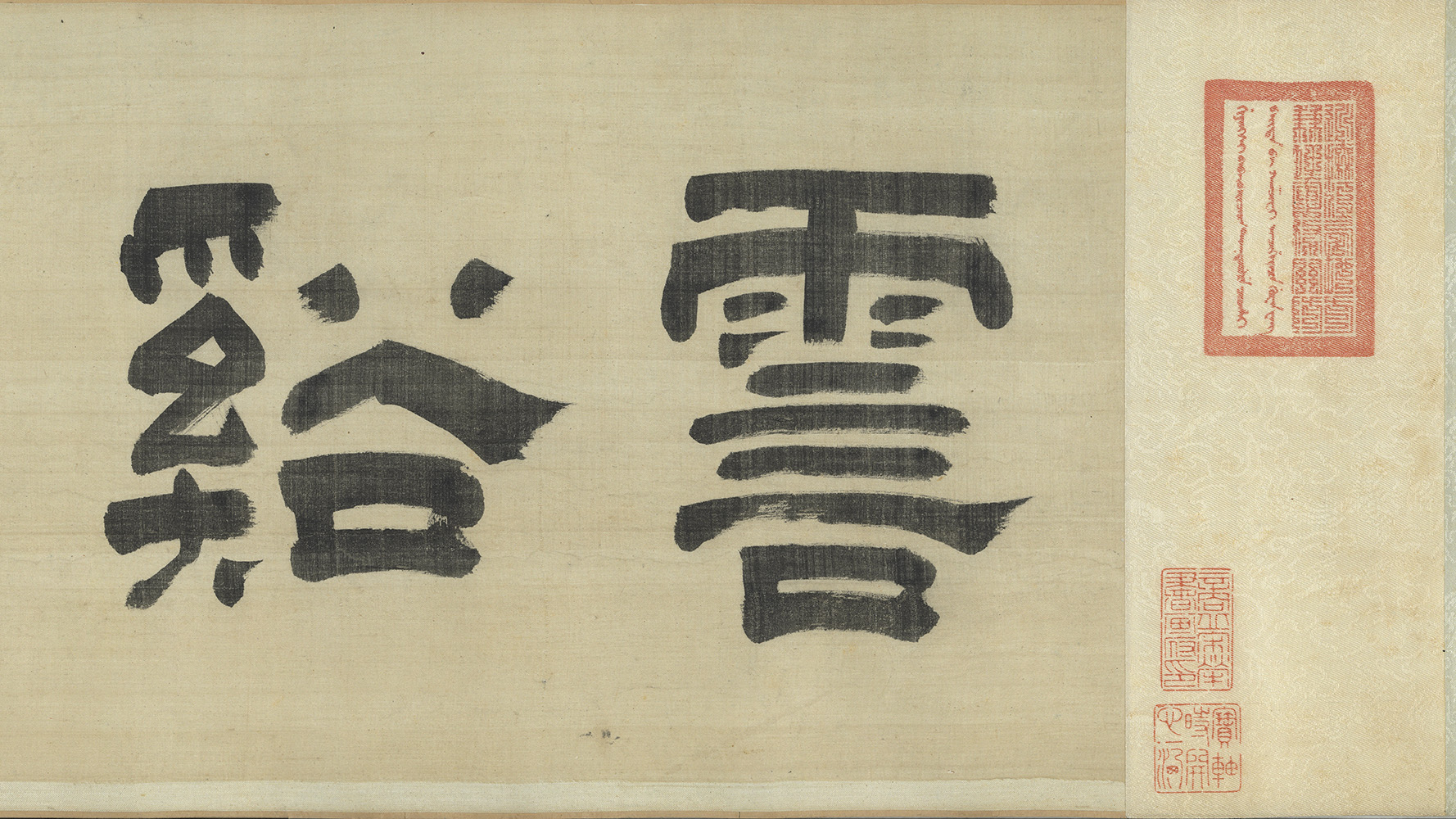
Song Qian selects peonies
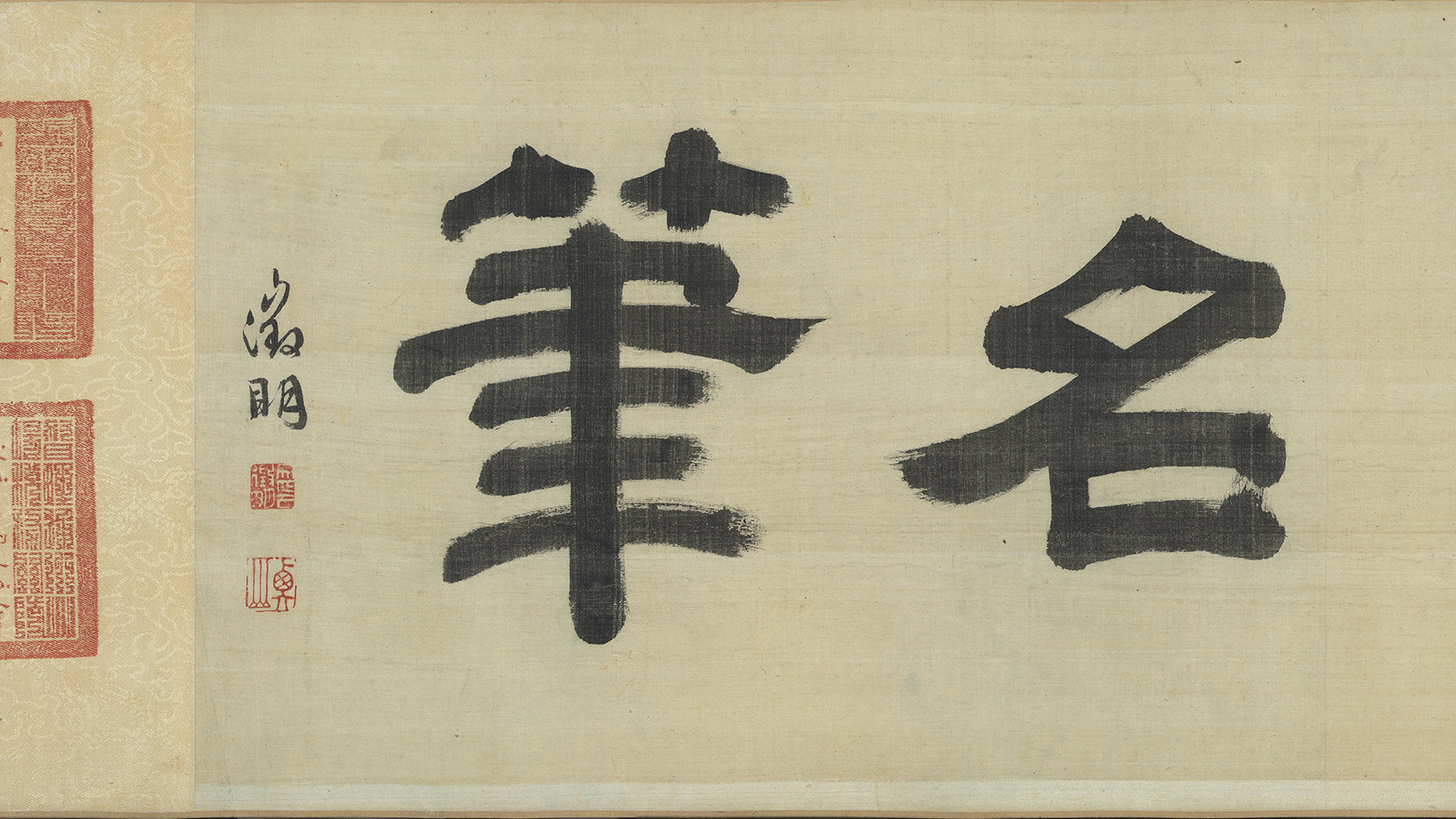
Song Qian selects peonies

Song Qian selects peonies
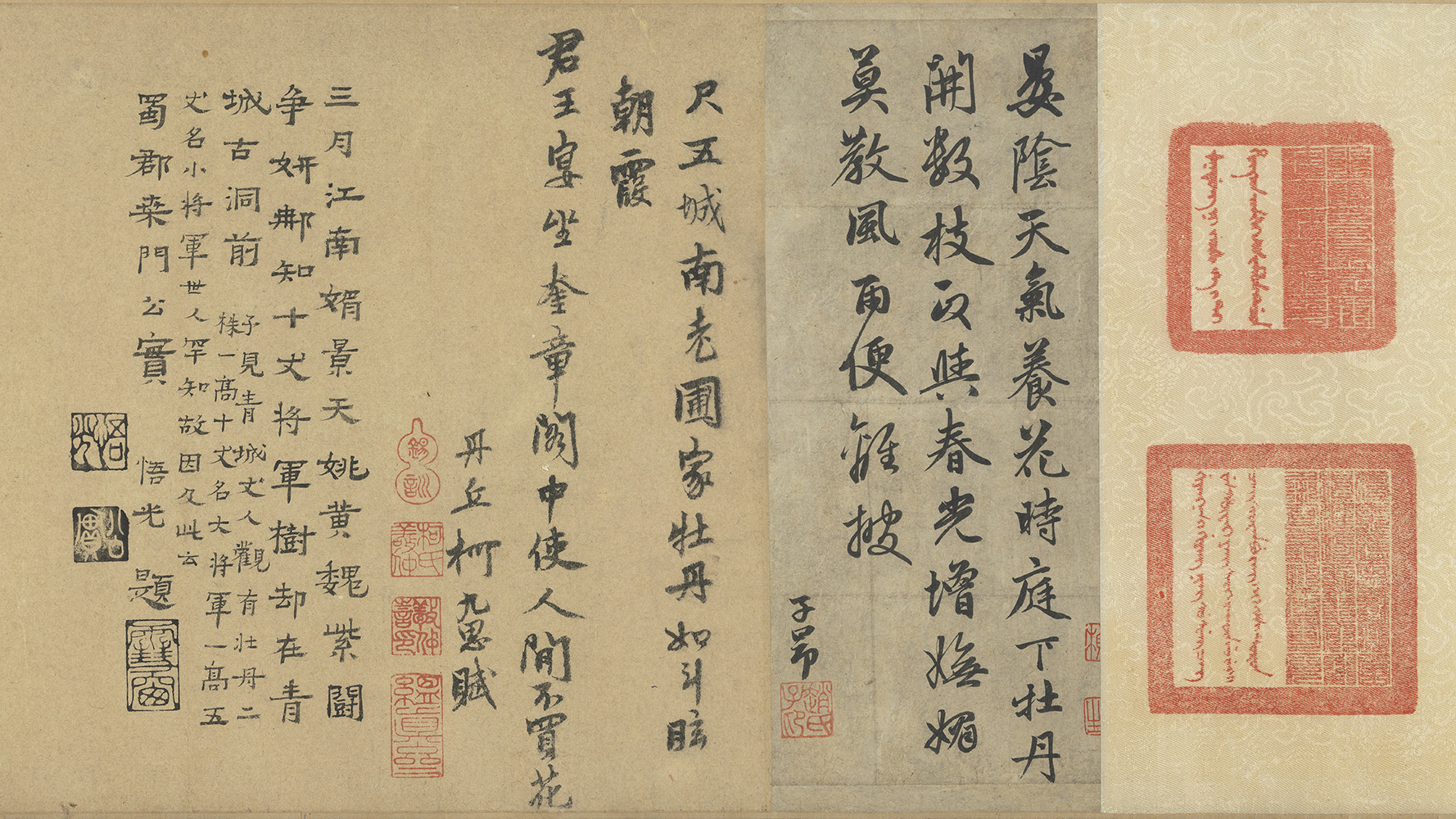
Song Qian selects peonies
Qian Xuan (1239-about 1301) was a native of Wuxing, Zhejiang. His courtesy name was Shunju, his nickname was Peixi Weng, etc. He was good at painting figures, flowers and birds, and landscapes. He was ranked among the "Eight Talents of Wuxing" together with Zhao Mengfu and others. In this painting of red and white peonies, the petals and leaves are full of delicate and winding outlines, lined with meshed leaf veins, creating a realistic and complex visual effect. The light and elegant colors suppress the contrast between flowers and leaves, and strip away the sense of space in the picture, flattening the objects and enhancing the taste of something ancient but not ancient, transcending reality. According to its "Pixi Weng" designation, it can be seen that it is a masterpiece in his later years.
Picture of Yuan Guo giving snow and bamboo

Picture of Yuan Guo giving snow and bamboo
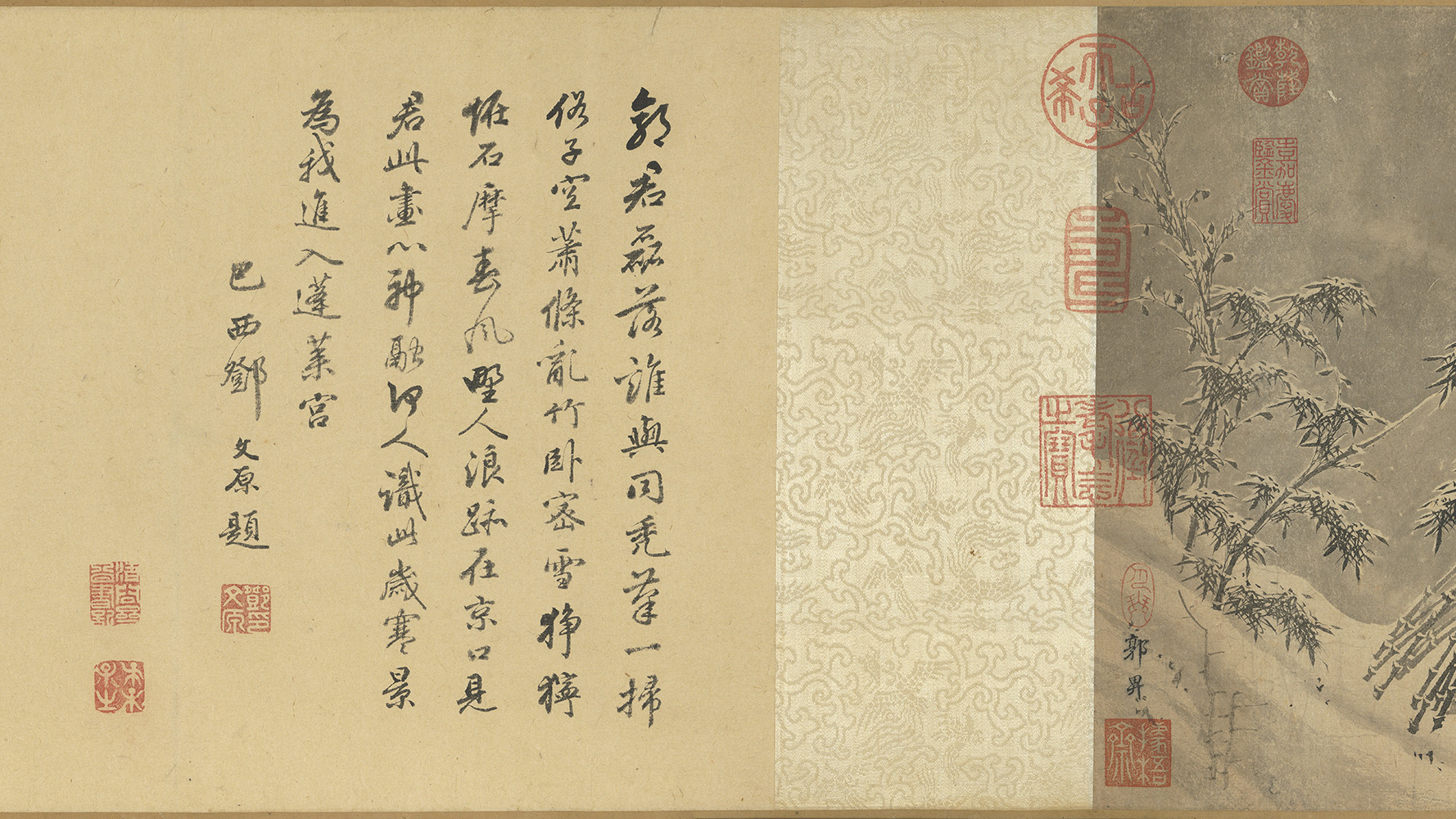
Picture of Yuan Guo giving snow and bamboo
Guo Jing (1280-1335), a native of Dantu County in present-day Jiangsu Province, had the courtesy name Tiancheng and the nickname Tuisi. He studied calligraphy and painting under the masters of Zhao Mengfu (1286-1319) and Gao Kegong (1248-1310). In this painting, Jiangzhu is severely cold and the green bamboo stands proud of the snow. The ink pen is used to write about dead wood, bamboo, and stone. The brushwork is completely imitated by Zhao Mengfu. The whole text is complex but not chaotic, with well-organized layers and accurate images. It also renders the background, leaving white space as snow, to express an empty, remote, desolate and lonely landscape. Although the bamboo clumps are tilted due to the snow, they are soft and unbroken, and they are not bent. In contrast to the lone trees, they show their tenacity and perseverance. It is both realistic and poetic.
(Note: The pictures and text are from the official website of the National Palace Museum in Taipei.)

